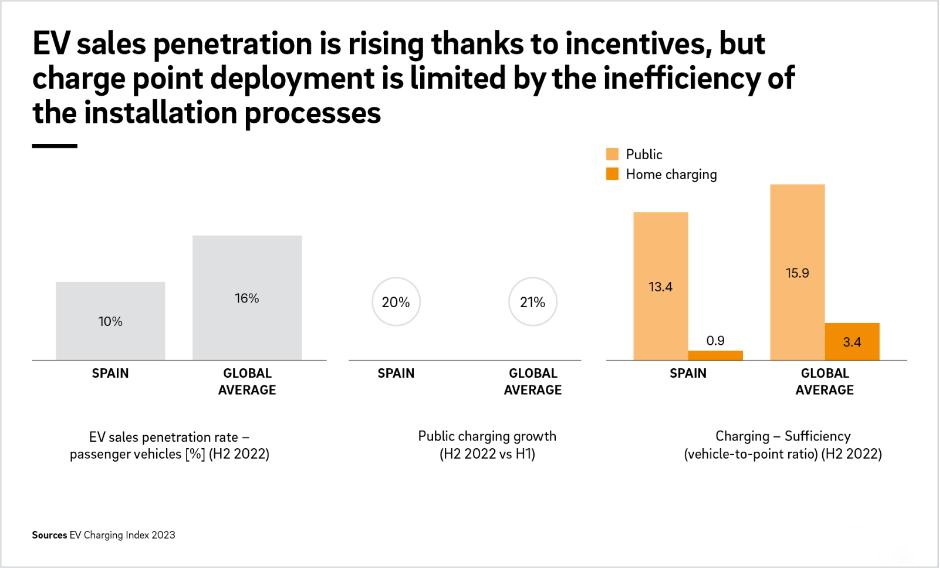Ev Charging Trends and Challenges in Spain
EV sales penetration in Spain is below the global average but beginning to rise quickly. The ratio of private charge points to EVs is currently among the top three worldwide, but administrative inefficiencies are hindering growth in public charge points, despite a dynamic market.
What are the current main trends around e-mobility in Spain?
The sales penetration rate for electric vehicles in Spain is 10%. This is below the global average of 16% but now rising quickly thanks to government incentives, both for individuals and companies transitioning fleets to EVs. On the charging side, Spain has launched aid programs to boost the deployment of infrastructure. Subsidies now average 30% per charging point, with maximums per company and region. There are also regulations requiring the installation of charging points at petrol stations, car parks and public buildings.
The main obstacle to charge point deployment isn’t a lack of commitment, but the inefficiency of the installation processes. It can take up to two years to obtain authorization or connect to the network, which has meant that 20-25% of total public charging points already installed cannot operate. As a result, the charging infrastructure is currently well behind the government's target of 100,000 charge points by 2023.

How would you describe key charging habits and demands among consumers?
EV owners are still largely affluent and use their cars for shorter, local trips. We estimate that 90% of EV owners charge at home or work, which explains Spain’s vehicle-to-point ratio of 0.9 for private charging – among the top three worldwide. The ratio for public charging, though, is 13.4 vehicles per charge point, just better than the global average of 15.9 and significantly inferior to the top-three average of 1.8. As the market matures, the user profile will change – most EV owners will not be able charge privately, increasing the need for public charge points. Some charge-point operators (CPOs), such as Zunder, are developing stations with extra customer services like music and shopping opportunities while vehicles are charging.
Charging infrastructure challenges in Spain
Similarly to its European neighbors, most of Spain’s public charging infrastructure consisted of alternating current (AC) chargers, which tend to provide slower recharging options than direct current (DC) charging as electric vehicle batteries store power as direct current. In fact, most of Spain’s public AC charging points were medium-speed chargers, with power between 7.4 and 22 kilowatts. Given the growing Spanish electric vehicle fleet, the country’s need for fast-charging solutions could also increase, particularly in areas with a low ratio of charging stations to inhabitants.
Furthermore, nearly 8,900 charging points were inactive at the end of the third quarter of 2023, representing over a quarter of the public charging infrastructure in the country. A third of Spanish consumers reported interest in installing an electric vehicle charging station at home in 2023 . However, a lack of garage space or single-family homes could be one of the largest hurdles to EV home charging, which might increase pressure on an already challenged Spanish charging infrastructure.
-
Heavy-Duty Vehicle Charging Revolution
Maxwell’s 50kW@1500Vdc air-cooled charging module is designed for the fast and efficient charging of electric heavy-duty vehicles. With 97% peak efficiency, wide voltage compatibility, and support for up to 60 parallel units, it enables scalable, high-power charging infrastructure for electric trucks and buses. Its compact, maintenance-friendly design makes it ideal for next-generation EV charging stations.
넶0 2025-07-29 -
What is the trend of integrated photovoltaic, storage and charging?
With the rapid growth of electric vehicle adoption and increasing electricity demand, traditional charging stations are falling short. Integrated photovoltaic, storage, and charging systems are emerging as a future-proof solution, combining solar power, energy storage, and EV charging into one smart, green infrastructure. This article explores the trend, benefits, real-world cases, and Maxwell’s latest solutions that support global low-carbon goals.
넶11 2025-07-22 -
Energy storage is leading the world
As AI continues to advance, the demand for efficient power conversion and energy storage grows. This article explores how renewable energy sources like wind and solar can be effectively stored and converted using DC-DC converters for AI data centers and electric aviation systems.
넶11 2025-07-15




















